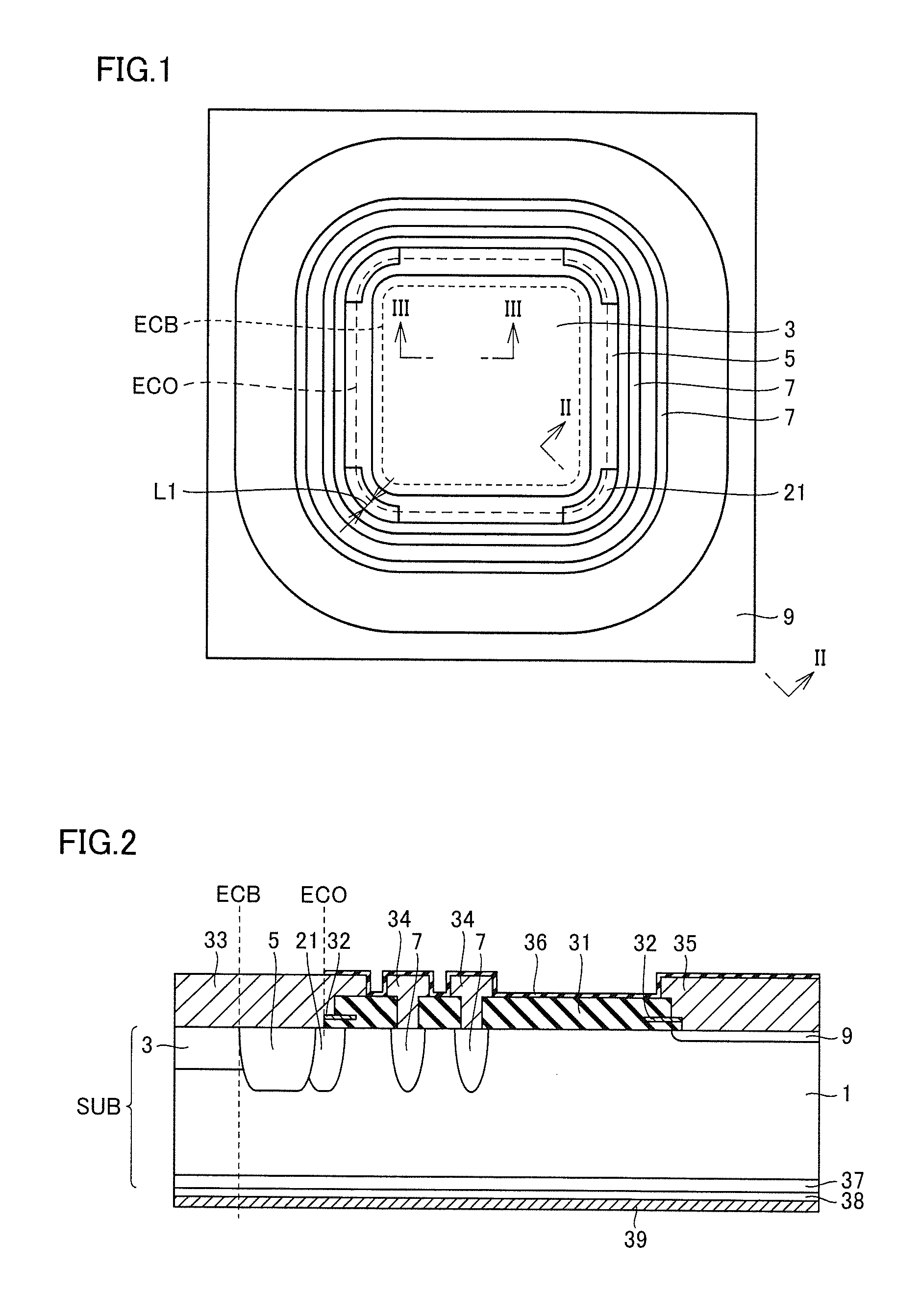Semiconductor device
a technology of semiconductor devices and semiconductors, applied in the direction of semiconductor devices, basic electric elements, electrical equipment, etc., can solve the problems of increased production costs, conventional semiconductor devices, etc., and achieve the effect of suppressing the breakdown of semiconductor devices due to local impact ionization
- Summary
- Abstract
- Description
- Claims
- Application Information
AI Technical Summary
Benefits of technology
Problems solved by technology
Method used
Image
Examples
first embodiment
[0039]An IGBT will be illustrated here as an example of the semiconductor device according to a first embodiment of the present invention, and a description will be given of a first example of the IGBT.
[0040]FIG. 1 is a plan view of the semiconductor device according to the first embodiment of the present invention, FIG. 2 is a cross section along a cross section line II-II shown in FIG. 1, and FIG. 3 is a cross section along a cross section line shown in FIG. 1. In the plan view of FIG. 1, components located on a semiconductor substrate that are depicted in the cross section of FIG. 2 are not shown for the sake of convenience. To be accurate, FIG. 1 illustrates a pattern (prior to heat treatment, corresponding to a mask pattern) for forming each impurity layer to be formed in the semiconductor substrate. The same is applied as well to the plan views referenced hereinafter.
[0041]As shown in FIGS. 1 and 2, an n− layer 1 is formed from one surface (first main surface) of a semiconduct...
second embodiment
[0065]Here, a second example of the IGBT will be described. FIG. 11 is a plan view of a semiconductor device according to a second embodiment of the present invention, and FIG. 12 is a cross section along a cross section line XII-XII shown in FIG. 11. As shown in FIGS. 11 and 12, a p low-concentration layer 21 having a relatively lower impurity concentration is formed in a corner region of p well layer 5. Emitter electrode 33 does not contact p low-concentration layer 21, and an interlayer insulating film 31 is interposed between emitter electrode 33 and p low-concentration layer 21. Since features other than the above-described ones are similar to those shown in FIGS. 1 and 2, the same components are denoted by the same reference characters and the description thereof will not be repeated.
[0066]An operation of the semiconductor device will now be described. The operation of this semiconductor device is basically identical to the operation of the semiconductor device described in co...
third embodiment
[0070]Here, a third example of the IGBT will be described. FIG. 13 is a plan view of a semiconductor device according to a third embodiment of the present invention, and FIG. 14 is a cross section along a cross section line XIV-XIV shown in FIG. 13. As shown in FIGS. 13 and 14, in a corner region of p well layer 5, p well layer 5 is partially formed in n− layer 1, and a portion (n− layer 22) of n− layer 1 in which p well layer 5 is not formed is located in the shape of an arc along the curve of the corner. Emitter electrode 33 fails to contact this n− layer 22 and also fails to contact the portion of p well layer 5 that is located outside this n− layer 22.
[0071]Furthermore, width W1 of n− layer 22 (the length in the direction substantially orthogonal to the direction of the tangent of the curve of the corner) is designed so that width W1 is larger than twice the width of lateral diffusion of p well layer 5 so as to prevent the portion of p well layer 5 that is located inside n− laye...
PUM
 Login to View More
Login to View More Abstract
Description
Claims
Application Information
 Login to View More
Login to View More - R&D
- Intellectual Property
- Life Sciences
- Materials
- Tech Scout
- Unparalleled Data Quality
- Higher Quality Content
- 60% Fewer Hallucinations
Browse by: Latest US Patents, China's latest patents, Technical Efficacy Thesaurus, Application Domain, Technology Topic, Popular Technical Reports.
© 2025 PatSnap. All rights reserved.Legal|Privacy policy|Modern Slavery Act Transparency Statement|Sitemap|About US| Contact US: help@patsnap.com



